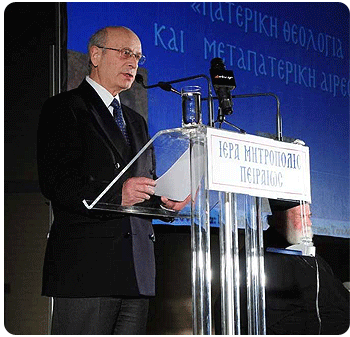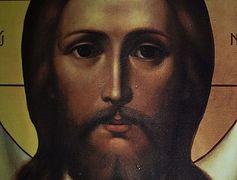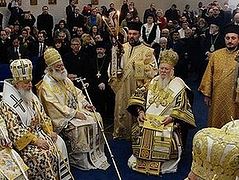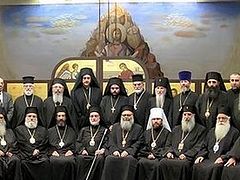Source: Impantokratoros
February 3, 2016

Professor of the Theological School at the Aristotle University of Thessaloniki, Dr. Demetrios Tselengidis has sent his first theological observations to the Orthodox hierarchs of several Local Orthodox Churches (including those of Greece, Russia, Serbia, Georgia, Bulgaria, Alexandria, and Antioch) concerning the text: “Relations of the Orthodox Church with the Rest of the Christian World.”
* * *
This text displays recurrent theological inconsistency and contradiction. Thus, in the first article it proclaims the ecclesiastical self-identity of the Orthodox Church, considering Her—and very rightly—as the “One, Holy, Catholic, and Apostolic Church.” In article six, however, there is a contradiction with respect to the formulation of the above article (1). It notes characteristically that the “the Orthodox Church recognizes the historic existence of other Christian Churches and Confessions not in communion with Her.”
Here the reasonable theological question arises: If the Church is “One” according to our Creed and the Orthodox Church’s own self-identity (art. 1), then how is there mention of other Christian Churches? It is clear that these other Churches are heterodox.
Heterodox “Churches”, though, cannot at all be called “Churches” by the Orthodox. Considering things from a dogmatic perspective it is not possible to speak about a plurality of “Churches” with different dogmas, and this, indeed, with regard to many different theological issues. Consequently, as long as these “Churches” remain firm in the erroneous beliefs of their faith, there is no theological justification to grant them ecclesial recognition —and this officially —outside of the “One, Holy, Catholic, and Apostolic Church.”
In the same article (6), there is another serious theological contradiction. At the beginning of the article the following is noted: “According to the ontological nature of the Church, it is impossible for [Her] unity to be shattered.” At the end of this same article, however, it is written that, by Her participation in the Ecumenical Movement, the Orthodox Church has as its “objective aim the paving of the way which leads toward unity.”
Here the question is put: Given that the unity of the Church is an acknowledged fact, what type of unity of Churches is being sought in the context of the Ecumenical Movement? Does it perhaps mean the return of Western Christians to the ONE and only Church? Such a meaning, though, does not emerge either in the letter or the spirit of the entire text. On the contrary, indeed, the impression is given that there exists a long-established division in the Church and that the prospects of the [Ecumenical] dialogues focus on the disrupted unity of the Church.
Theological confusion is also caused by the ambiguity in article 20, which reads: “The prospects of the theological dialogues of the Orthodox Church with the other Christian Churches and Confessions shall always be determined on the basis of Her canonical criteria of the already established ecclesiastical tradition (canon seven of the Second Ecumenical Council and canon 95 of the Quinisext Council).”
But, canon seven of the Second Ecumenical Council and canon 95 of the Quinisext address the reception of specific heretics that had demonstrated their desire to join the Orthodox Church. However, it is apparent from the letter and spirit of the text, as judged from a theological perspective, that there is no discussion whatsoever of the return of the heterodox to the Orthodox Church, the only Church. Rather, in the text, the baptism of the heterodox is considered an accepted fact from the outset—and this without a Pan-Orthodox decision. In other words, the text endorses “Baptismal Theology.” Simultaneously, the text deliberately ignores the historic fact that the contemporary heterodox of the West (RC & Protestant) have not one, but heaps of dogmas that differ from the Orthodox Church (besides the filioque, created grace in the sacraments, the primacy of the pope, papal infallibility, the rejection of icons, and the rejection of the decisions of the Ecumenical Councils, etc.).
Article 21 also raises appropriate questions, where it notes that, “the Orthodox Church ... has a favorable view of the documents adopted by the Commission [referring to the Committee for ‘Faith & Order’] . . . for the rapprochement of the Churches.” Here it must be observed that these documents [of the Committee] have never been adjudged by the Hierarchs of the Local Orthodox Churches.
Finally, in article 22 the impression is given that the Upcoming Holy and Great Council is prejudging the infallibility of its decisions, since it considers that, “the preservation of the authentic orthodox faith is ensured only through the synodical system, which has always rested in the Church and which constitutes the appropriate and final judge on all matters of faith.” In this article, the historic fact is ignored that in the Orthodox Church the final criteria is always the living dogmatic consciousness of the fullness of the Church, which in the past confirmed even Ecumenical Councils considered robber councils. The synodical system by itself does not mechanically ensure the correctness of orthodox faith. This only happens when the Synod of Bishops has the Holy Spirit and the Hypostatic Way—Christ—working within it, and thus as “syn”—“odikoi” [i.e., “traversing together on the way”] they are, in practice, “following the Holy Fathers.”
General Assessment of the Text
With all that is written and what is clearly implied in the text above, it is clear that its initiators and authors are attempting the institutional and official ratification of Christian Syncretistism-Ecumenism by means of a Pan-Orthodox Synod. This, however, would be catastrophic for the Orthodox Church. For this reason I humbly propose the text’s total withdrawal.
* * *
In closing, one theological observation on the text, “The Sacrament of Marriage and its Impediments.” In article 5.i, it notes: “The marriage of an Orthodox person with a heterodox person is not permitted according to canonical akrivia [the ‘rule’] (canon 72 of the Quinisext Council in Trullo). However, it is possible to be blessed through condescension and love for man under the express condition that the children of this marriage will be baptized and raised in the Orthodox Church.”
Here, the express condition that, “the children of this marriage will be baptized and raised in the Orthodox Church” clashes with the theological guarantee of marriage as a sacrament of the Orthodox Church. The reason for this: because child-bearing shows itself—in connection with the baptism of children in the Orthodox Church—to legitimize the service of mixed marriage, something clearly forbidden by a Canon of the Ecumenical Councils (canon 72 of the Quinisext). In other words, a synod that is not Ecumenical, such as is the upcoming Holy and Great Council, explicitly turns a decision of an Ecumenical Council into something relative. This is unacceptable.
And finally this: If the blessed marriage does not provide children, is this marriage theologically legitimized simply on account of the intention of the heterodox spouse to place any possible children in the Orthodox Church?
For the sake of theological consistency, article 5.i, needs to be removed.




Likewise, you are ignorant of the writings of those leading ecumenists who are influential in writing this document, such as Metropolitan Chrysostomos of Messenia, or, less so, Professor Stylianos Tsompanidis. See their endorsement of baptismal minimalism and their reading of article 20 as supporting it: http://pemptousia.com/2015/12/relations-between-the-orthodox-church-and-other-christian-churches-on-the-basis-of-pan-orthodox-decisions-3/ and http://pemptousia.com/2016/01/an-ecclesiological-approach-on-the-road-to-the-holy-and-great-synod-5/ .
Finally, the hierarchy you refer to has nothing to do with their "eccclesial" nature which the ecumenists would like to grant. It has only to do with how easy or hard it may be for some of them to overcome their dogmatic errors and return to the Orthodox Faith. This is a matter of mission and pastoral discernment and not a matter of ecclesiology."
What does phyletism or xenophobia have to do with this dogmatician's theological analysis?
There is nothing nuanced about accepting "ecclesiality" and thus undermining the Church's Faith in the One Church.
If you are at all familiar with the texts of Vatican II, reading this would call to mind the double-mindedness of those documents.
You do not know what the "pan-heresy" of ecumenism is, for you equate it simply with ecumenical engagement. It is a confusion or denial of the Orthodox Church being the One, Holy Catholic and Apostolic Church. This is a matter of dogma not a political or social matter.
Whatever do you mean? Orthodoxy has existed throughout foreign lands in the Middle East since forever. How do you conclude that She hates or fears foreigners?
"No one is suggesting syncretism" said the spider to the fly.
"Fulminating fringe elements"? Ah yes--those non-inclusive haters.
Peregrinus ... the text was written and supported by leading ecumenists who are influential in writing this document, here is just one example of "baptismal theology-ecclesiology", see their endorsement of baptismal minimalism :
http://pemptousia.com/2016/01/an-ecclesiological-approach-on-the-road-to-the-holy-and-great-synod-5/
The only way to destroy the Church of Christ is from within. Perhaps THAT should be the focus of the Council - weeding out the infiltration elements in the Church. Everyone knows that the hierarchy has suffered from Masonic and Jesuit compromise - why not address this openly? Look at the effects of Masons such as Athenagoras and Metaxakis, they have only caused schism and pain. The Orthodox Church can not afford to allow men like this to become bishops any longer.
Ecumenical engagement is an imperative. No one is suggesting syncretism. In fact the text is question unequivocally condemns the "equality of confessions" and likewise, rightly condemns the fulminating fringe elements who oppose ecumenical engagement as a "pan-heresy." Zeal without knowledge at best, mockers of Christ at worst.
"Baptismal" minimalism is nowhere endorsed in the document, but the "hierarchy of difficulties" is considered in light of the varying distances of heterodox bodies from the Church on the basis of their sacramental self-understandings and apostolic succession.